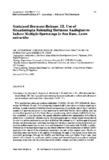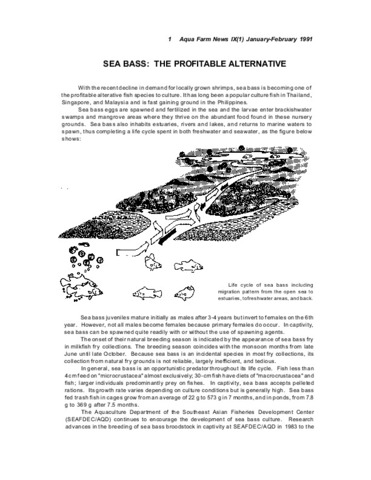Sustained hormone release. III. Use of gonadotropin releasing hormone analogues to induce multiple spawnings in sea bass, Lates calcarifer
- Global styles
- MLA
- Vancouver
- Elsevier - Harvard
- APA
- Help
Share
抄録
Two gonadotropin releasing hormone analogues (GnRHa), [D-Ala6, Pro9-ethylamide] mammalian GnRH and [D-Arg6, Pro9-ethylamide] salmon GnRH, were shown to induce spawning in see bass. A single injection of GnRHa induced one spawning, but multiple (two to four) injections spaced 24 h apart produced one to four spawnings in individual females. More striking were the sea bass that spawned up to five times after an osmotic pump, which releases GnRHa for 14 days, was implanted. A less expensive, but equally effective method was implantation of GnRHa in pellets with a cholesterol-cellulose matrix. Multiple spawnings in a single female were produced by only two pellets implanted at one time; individual fish released up to 7 million eggs with good fertility and hatching rates. Individual sea bass were shown to remature in the same season and produce multiple spawnings in both June and September if stimulated with GnRHa in pellets. Stimulation of multiple spawnings was not clearly different if the mammalian or salmon GnRH analogues were used or if the stimulation occurred at the new or first quarter moon. Finally, an individual male was shown to be capable of fertilizing the eggs of one female for at least four sequential spawnings, although the fertility and hatching rates were higher if two males were placed with a female. In conclusion, pellets, pumps and repeated injections produced multiple spawnings in sea bass, but the pellets were more reliable, cheaper, and less stressful to the fish.
Suggested Citation
Almendras, J. M., Duenas, C., Nacario, J., Sherwood, N. M., & Crim, L. W. (1988). Sustained hormone release. III. Use of gonadotropin releasing hormone analogues to induce multiple spawnings in sea bass, Lates calcarifer. Aquaculture , 74(1–2), 97-111. https://doi.org/10.1016/0044-8486(88)90090-7
Type
ArticleISSN
0044-8486Collections
- Journal Articles [1258]
Related items
Showing items related by title, author, creator and subject.
-
Influence of LHRHa and methyltestosterone on milt production of sea bass Lates calcarifer (Bloch)
Hilomen-Garcia, G. V.; Baldevarona, R. B.; Lacanilao, F. J. (Aquaculture Department, Southeast Asian Fisheries Development Center, 1996)Milt volume, sperm density, and number of spermatozoa were determined to quantify milt production of mature sea bass after a single injection of LHRHa [(D-Ala6,Pro9-N-ethylamiide)LHRH] in saline solution and 17α-methyltestosterone ... -
Milt production of sea bass Lates calcarifer Bloch administered an analogue of luteinizing hormone-releasing hormone and 17α-methyltestosterone
Hilomen-Garcia, G. V.; Baldevarona, R. B.; Lacanilao, F. (Society of Israeli Aquaculture and Marine Biotechnology, 2002)The milt production responses of sexually mature sea bass Lates calcarifer to (D-Ala6, Pro9-N- ethylamide) luteinizing hormone-releasing hormone (LHRHa) and 17α-methyltestosterone injections were ... -
Sea bass: The profitable alternative
Southeast Asian Fisheries Development Center, Aquaculture Department (Aquaculture Department, Southeast Asian Fisheries Development Center, 1991)






